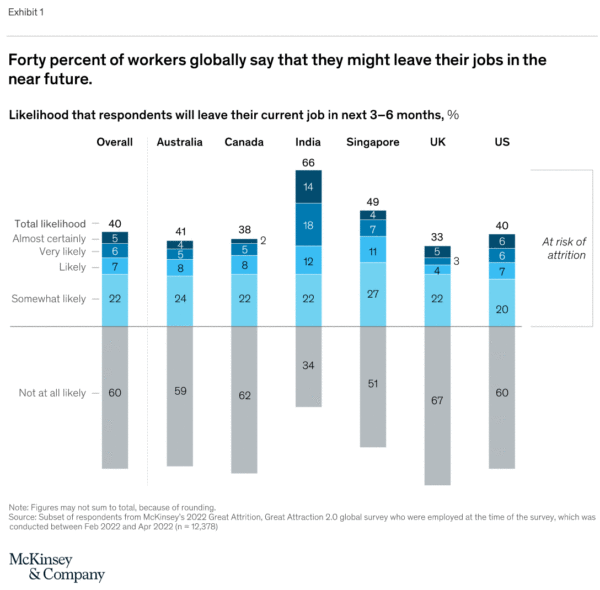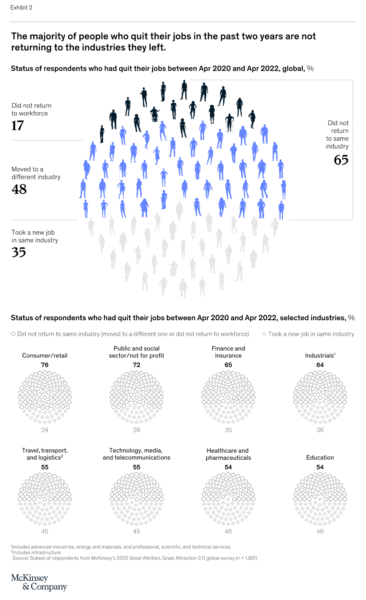The Great Attrition is making hiring harder. Are you searching the right talent pools?
July 15, 2022

By Aaron De Smet, Bonnie Dowling, Bryan Hancock, and Bill Schaninger
The Great Attrition is making hiring harder. Are you searching the right talent pools?
People keep quitting at record levels, yet companies are still trying to attract and retain them the same old ways. New research identifies five types of workers that employers can reach to fill jobs.
It’s the quitting trend that just won’t quit. People are switching jobs and industries, moving from traditional to nontraditional roles, retiring early, or starting their own businesses. They are taking a time-out to tend to their personal lives or embarking on sabbaticals. The Great Attrition has become the Great Renegotiation.
Competition for talent remains fierce. For certain categories of workers, the barriers to switching employers have dropped dramatically. In the United States alone, there were 11.3 million open jobs at the end of May—up substantially from 9.3 million open jobs in April 2021. Even as employers scramble to fill these positions, the voluntary quit rate is 25 percent higher than prepandemic levels. At the current and projected pace of hiring, quitting, and job creation, openings likely won’t return to normal levels for some time.
What we are seeing is a fundamental mismatch between companies’ demand for talent and the number of workers willing to supply it. Employers continue to rely on traditional levers to attract and retain people, including compensation, titles, and advancement opportunities. Those factors are important, particularly for a large reservoir of workers we call “traditionalists.” However, the COVID-19 pandemic has led more and more people to reevaluate what they want from a job—and from life—which is creating a large pool of active and potential workers who are shunning the traditionalist path.
As a result, there is now a structural gap in the labor supply because there simply aren’t enough traditional employees to fill all the openings. Even when employers successfully woo these workers from rivals, they are just reshuffling talent and contributing to wage escalation while failing to solve the underlying structural imbalance.
To close the gap, employers should try to win back nontraditional workers. But how?
Our research identified distinct pools of workers with varied workplace priorities. Their differences show that employers have to take a multifaceted approach to attract and retain talent.
To better understand who might fill all the open jobs, we examined economic and labor statistics; conducted a large global survey to learn more about what is driving people to stay, leave, or return; and applied advanced analytics to define specific segments of the workforce, both active and latent (see sidebar, “About the research”).
Our analysis of workers in six countries focuses on which job attributes are motivating them, both positively and negatively. We asked survey participants in various phases of job churn why they left or would consider leaving and what would make them want to stay or come back. It turns out that many workers want more than the usual compensation and job advancement carrots.
To get at these priorities, we sorted respondents into smaller groups who shared the same set of primary needs that they want an employer to meet. Then we looked at whether these workers also shared demographic similarities. These groups of like-minded respondents became our “personas”—distinct pools of workers that employers can target in their search for talent. While most of these groups valued workplace flexibility highly, they differed in how they rated mental-health support, meaningful work, and career advancement.
These differences show that no single solution is going to attract enough people to fill all the job openings and retain a productive workforce. Instead, employers can take a multipronged approach to reach different talent pools. This doesn’t mean that organizations have to change their mission, values, or purpose. Rather, they can showcase different facets of their employee value proposition to a broader number of workers and get more creative in their offers to current and potential employees.
In this article, we take a closer look at five crucial employee personas that companies must understand to solve the attrition and attraction problem for the longer term.
New trends make the employment picture more complex
Despite significant changes in the economy since the onset of the Great Attrition (or what many call the Great Resignation), the share of workers planning to leave their jobs remains unchanged from 2021, at 40 percent. That’s two out of five employees in our global sample who said that they are thinking about leaving in the next three to six months.
However, the past year has revealed nuances of the larger trend:
- Reshuffling. Employees are quitting and going to different employers in different industries (48 percent of the job leavers in our sample). Some industries are disproportionately losing talent, others are struggling to attract talent, and some are grappling with both.
- Reinventing. Many employees leaving traditional employment are either going to nontraditional work (temporary, gig, or part-time roles) or starting their own businesses. Of the employees who quit without a new job in hand, 47 percent chose to return to the workforce. However, only 29 percent returned to traditional full-time employment.
- Reassessing. Many people are quitting not for other jobs but because of the demands of life—they need to care for children, elders, or themselves. These are people who may have stepped out of the workforce entirely, dramatically shrinking the readily available talent pool.
Globally, employees are considering their options
While there is ample evidence that this workforce discontent is a global phenomenon, the situation has further deteriorated in certain markets. In India, more than 60 percent of respondents expressed a desire to leave their current posts, well above their counterparts in Australia, Canada, the United Kingdom, and the United States. Workers in Singapore showed the second-highest level of job discontent, at 49 percent (Exhibit 1).

Respondents across the six countries showed a consistently high desire for work that is better paying, more satisfying, or both, as well as a conviction that they can find better jobs elsewhere. As our research has shown, some workers are leaving their jobs and the workforce, ready for a break and confident in their ability to find another job when they want to. Indeed, almost three-quarters of employed respondents believe that it would not be difficult to find a job that pays the same or better, with the same or better benefits.
Mobility between industries is high
Vitally, companies can no longer assume that they can fill empty slots with workers similar to the ones who just left. Globally, just 35 percent of those who quit in the past two years took a new job in the same industry. In finance and insurance, for instance, 65 percent of workers changed industries or did not return to the workforce. In the public and social sector, the exodus was even greater, at 72 percent (Exhibit 2).

In some areas, these losses may reverberate for some time. In travel, healthcare, and consumer retail—industries hit hard during the pandemic—at least 18 percent of respondents who quit their jobs are choosing to forgo employment entirely rather than work in the same or any other industry again.
There are bright spots for workers, however. For those with sought-after skills such as data scientists and programmers, the hurdles to changing industries are lower. Companies are more focused on hiring people for their skills rather than their industry experience, and the most talented individuals with the most sought-after skills will be able to continue to explore options to find the best fit. There is less of a stigma attached to job hopping or gaps in a résumé, and joining companies in other geographies without relocating has become easier than ever, making it possible for people to jump from one employer to another.
These factors create a new playing field for hiring, since employers find themselves competing not only within their industry, as in the past, but also across industries.






























